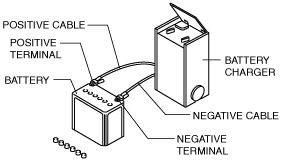BATTERY RECHARGING
id011700800700
-
Warning
-
• Keep all flames away from the battery and perform the servicing in a well-ventilated area. Otherwise, evaporated gas from the battery could ignite.
• Remove the battery filler caps when recharging to prevent battery deformation or damage.
• Do not perform battery recharging with the battery in the vehicle as it is dangerous.
• When connecting to the battery recharger, make sure the battery terminals are connected correctly.
Vehicles with i-stop and i-ELOOP
-
Caution
-
• Do not perform quick recharging. If quick recharging is performed it could result in an i-stop control malfunction.
• After recharging, leave the battery as it is for as long as possible (6 hours or longer recommended) to dissipate the polarization in the battery.
1. Remove the battery. (See BATTERY REMOVAL/INSTALLATION.)
2. Remove the battery filler caps.
3. To prevent loss of battery fluid during recharging, verify the battery fluid level.
-
Battery fluid level is halfway between UPPER and LOWER levels or less
-
• Add distilled water to the upper level.
-
Battery fluid level is halfway between UPPER and LOWER levels or more
-
• Go to the next step.
4. Connect a battery recharger to the battery and adjust the charging current as follows.
-
Constant current recharger device available
-
1. Apply a constant current charge according to chart 1. Refer to chart 2 for the charging time.
Battery charging procedure (Chart 1)
|
Battery
|
Recharge current
|
|
Q-85
|
10-15A
(10.4A if digital setting is possible)
|
Battery recharge time (Chart 2)
|
Cell with lowest electrolyte gravity
|
1.24 or more
|
1.23
|
1.22
|
1.21
|
1.20
|
1.19
|
1.18
|
1.17
|
|
Charge time (min)
|
180
|
200
|
220
|
240
|
270
|
290
|
330
|
360
|
-
No constant current recharger device available
-
1. Using a constant voltage battery charger, adjust the voltage so that the recharge current is as indicated in chart 1. Verify the current after 30 s have elapsed since the measurement was started because the current is not stabilized after the voltage adjustment.
2. Charge the battery for 60 min using current in Step (1).
3. Readjust so that the recharge current is as indicated in chart 1.
4. Charge the battery so that the total time for Step (2) is the time in chart 2.
5. Measure electrolyte gravity of all cells.
-
Cell with lowest electrolyte gravity is less than 1.25
-
-
Cell with lowest electrolyte gravity is 1.25 or more
-
Vehicles without i-stop and i-ELOOP
-
Caution
-
• Do not quick charge for more than 30 min. It will damage the battery.
1. Remove the battery. (See BATTERY REMOVAL/INSTALLATION.)
2. Remove the battery filler caps.
3. Connect a battery charger to the battery and adjust the charging current as follows.
-
Battery slow charge current
-
55D23L (55 A·h/20HR): 4.5—5.5 A
75D23L (65 A·h/20HR): 5.0—6.0 A
-
Battery quick charge current [30 min]
-
55D23L (55 A·h/20HR): 30 A
75D23L (65 A·h/20HR): 35 A
4. After the battery is recharged, verify that the voltage is within the specification and remains at the same value for 1 h or more after the recharging has been completed.
-
• If not within the specification, replace the battery.
-
Standard voltage
-
12.4 V or more
